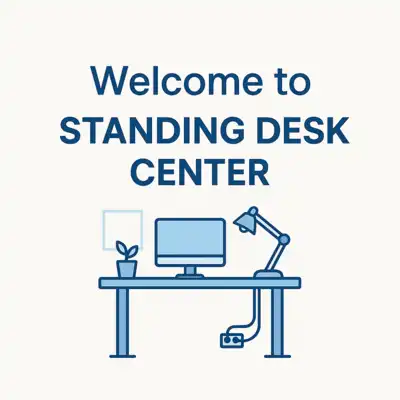Calculate Your Ideal Standing Desk

Did you know that proper ergonomics can significantly boost not only your comfort but also your productivity? A well-structured workspace can be the key to a healthier work life. Let's dive into the essential takeaways that can transform your workspace into an ergonomic haven.
What You Will Learn
- Reduced Physical Strain: A proper ergonomic setup minimizes muscle strain by ensuring the right alignment of furniture and equipment.
- Improved Posture: An ergonomic workspace encourages a natural posture, significantly reducing back and neck pain.
- Increased Productivity: Comfort in your workspace leads to enhanced focus and efficiency, allowing for a more productive workday.
- Health Risks of Incorrect Desk Height: A desk that is too high or low can cause neck, shoulder, and back pain as well as wrist issues.
- Sedentary Lifestyle Effects: Long periods of sitting can lead to weight gain, heart disease, and decreased energy levels; integrating movement is crucial.
- Importance of Continuous Adjustments: Regularly evaluating and adjusting your workspace is vital for long-term comfort and productivity.
- DIY Tools for Ergonomics: Using a DIY standing desk height calculator can help you find your optimal desk height and improve your setup.
Key Benefits of an Ergonomic Workspace
Understanding the advantages of an ergonomic setup can significantly impact your health and productivity. Below is a visual overview of these benefits illustrated through key statistics.
Reduced Physical Strain
Proper alignment of your desk, chair, and monitor can prevent muscle strain, enhancing comfort and reducing fatigue.
Improved Posture
An ergonomic workspace encourages a natural posture that reduces back and neck pain, promoting long-term health.
Increased Productivity
When you’re comfortable, you’re more likely to focus and accomplish tasks efficiently, leading to greater output.
Combat Sedentary Lifestyle
Incorporating movement into your workday reduces risks associated with prolonged sitting, such as heart disease and weight gain.
Understanding the Importance of Ergonomics in Your Workspace
When I talk about ergonomics, I mean setting up your workspace to keep you comfortable and productive. It's all about arranging furniture and equipment so you can work efficiently without straining your body. At Standing Desk Center, I can't stress enough how an ergonomic setup can boost not only your health but also your productivity!
Many people underestimate the impact of their workspace on their well-being. An ergonomic setup can help reduce fatigue, enhance focus, and even improve your mood. Imagine working without those annoying aches and pains—sounds great, right?
Why Ergonomic Setup Matters for Health and Productivity
Creating a workspace that is focused on ergonomics can lead to remarkable benefits. Here are some key reasons why it matters:
- Reduced Physical Strain: Proper alignment of your desk, chair, and monitor prevents muscle strain.
- Improved Posture: An ergonomic workspace encourages a natural posture that reduces back and neck pain.
- Increased Productivity: When you're comfortable, you're more likely to focus and get work done efficiently.
It’s essential to remember that the right setup contributes not only to comfort but to your overall performance. I’ve seen firsthand how a well-designed workspace can transform the way you work!
Subscribe
💡 Need a full cable management strategy for standing desks? Check out our complete guide to managing cords, motor wires and accessories. 👉 Read the Cable Management 101 Guide
Consequences of Incorrect Desk Height on Well-being
Incorrect desk height is a common issue that can lead to various health problems. If your desk is too high or too low, you might experience:
- Neck and Shoulder Pain: Leaning forward or looking down can strain your neck and shoulders.
- Wrist Issues: An improper keyboard height can lead to wrist pain or carpal tunnel syndrome.
- Back Problems: Sitting or standing at the wrong height can cause chronic back pain.
Adjusting your desk to the right height may seem like a small change, but it can significantly improve your comfort and health over time.
Impact of Sedentary Lifestyle on Workplace Health
In today's digital age, many of us spend hours sitting at our desks, which can have serious effects on our health. A sedentary lifestyle is linked to:
- Weight Gain: Sitting too much can contribute to weight issues.
- Heart Disease: Prolonged inactivity raises the risk of cardiovascular problems.
- Decreased Energy Levels: Lack of movement can make you feel sluggish and less motivated.
Incorporating standing desk solutions can combat these issues. At Standing Desk Center, I encourage everyone to find ways to integrate movement into their workday. Trust me; your body will thank you!
Pro Tip
Did you know? Regularly changing your position throughout the day can significantly reduce the risk of musculoskeletal disorders. Aim to alternate between sitting and standing every 30 to 60 minutes. This simple practice not only helps in maintaining good posture but also keeps your energy levels high and productivity on point!
Frequently Asked Questions (FAQs)
- What are the primary benefits of an ergonomic workspace?
- An ergonomic workspace reduces physical strain, improves posture, and increases productivity.
- How does incorrect desk height affect my health?
- Incorrect desk height can lead to neck and shoulder pain, wrist issues, and chronic back problems.
- What are the risks associated with a sedentary lifestyle in the workplace?
- A sedentary lifestyle is linked to weight gain, heart disease, and decreased energy levels.
- How can I determine the correct height for my standing desk?
- Measure your height, account for shoe height, use a DIY calculator, and adjust regularly for comfort.
- Why is it important to continuously adjust my workspace?
- Continuous adjustments ensure your workspace meets your body’s changing needs, promoting long-term comfort and productivity.
- What health benefits come from having a dynamic workspace?
- Alternating between sitting and standing can reduce chronic disease risk, enhance mood, and boost productivity.
Summarizing Key Takeaways for Your Perfect Ergonomic Setup
As we wrap up our discussion on creating the perfect ergonomic setup, it's essential to reflect on the critical steps for determining your ideal desk height. Remember, the right height is not just about comfort; it directly impacts your health and productivity! Here’s a quick recap of the main steps to get you started:
- Measure Your Height: Stand straight and measure from the floor to your elbow, keeping your arms at a 90-degree angle.
- Account for Shoe Height: Don’t forget to include the height of the shoes you typically wear!
- Input Your Measurements: Use a DIY standing desk height calculator to find your optimal desk height.
- Adjust Regularly: As you work, remember to make adjustments based on your comfort and posture.
By following these steps, you’ll be on your way to a more comfortable and efficient workspace. I believe that with the help of tools like a DIY standing desk height calculator from Standing Desk Center, achieving this isn’t just a dream. It’s very much attainable!
Final Thoughts on the Importance of Continuous Adjustments
As we navigate our busy workdays, it’s easy to forget that our body’s needs change! That’s why continuous adjustments to your workspace are vital. Keep in mind that what feels right one day might not feel the same the next. This is especially true for those of us who spend long hours at our desks.
It’s a good practice to regularly evaluate your setup. A small adjustment in chair height or monitor position can significantly influence your comfort and productivity. Always listen to your body—if you’re feeling discomfort, it’s time to reassess your setup!
At Standing Desk Center, we understand the importance of these adjustments, and we’re here to guide you every step of the way!
To ensure you're selecting the right equipment for your ergonomic workstation, it's helpful to consult resources that offer detailed guidelines. The Occupational Safety and Health Administration (OSHA) provides valuable checklists and purchasing guides to help you make informed decisions about computer workstations, ensuring they meet ergonomic standards. These resources can assist in creating a workspace that promotes comfort and reduces the risk of injury; follow this link to view the OSHA's purchasing guide for computer workstations.
Encouraging Engagement for Optimal Workstation Setup
Invite Readers to Share Their Ergonomic Setup Experiences
I want to hear from you! Have you made changes to your workspace that improved your comfort and productivity? Sharing your experiences can help others on their journey to creating an ergonomic setup!
Feel free to drop your stories in the comments below. Maybe you’ve found a unique way to manage cables or adjusted your desk height for the perfect fit. We can learn a lot from each other!
Call to Action: Try Using a DIY Standing Desk Height Calculator Today
If you haven’t already, I encourage you to try out a DIY standing desk height calculator. It’s a simple yet powerful tool that can transform your workspace. By entering a few measurements, you’ll find the ideal desk height tailored just for you!
Don’t wait any longer—start your journey toward a more ergonomic workspace today! Trust me; your body will thank you!
Exploring Health Benefits of Dynamic Workspaces
Finally, let’s not forget the health benefits associated with dynamic workspaces! Shifting between sitting and standing can:
- Reduce the risk of chronic diseases.
- Enhance mood and energy levels.
- Improve circulation and reduce fatigue.
- Boost overall productivity and focus.
Creating a dynamic workspace isn’t just about aesthetics; it’s about creating an environment that promotes health and well-being. By making ergonomic adjustments and incorporating standing desk solutions, we can significantly enhance our daily work experience!
So, let’s take those steps together and make our workspaces healthier, one adjustment at a time!
Recap of Key Points
Here’s a quick recap of the important points discussed in the article:
- Ergonomic Setup Matters: An ergonomic workspace reduces physical strain, improves posture, and increases productivity.
- Consequences of Incorrect Desk Height: Improper desk height can lead to neck and shoulder pain, wrist issues, and chronic back problems.
- Sedentary Lifestyle Risks: A sedentary lifestyle is linked to weight gain, heart disease, and decreased energy levels.
- Steps for Optimal Desk Height: Measure your height, account for shoe height, use a DIY calculator, and adjust regularly for comfort.
- Continuous Adjustments: Regularly evaluate and adjust your workspace to meet your body’s changing needs.
- Health Benefits of Dynamic Workspaces: Alternating between sitting and standing can reduce chronic disease risk, enhance mood, and boost productivity.
Popular Posts
 What if the key to a more productive workspace is simply organizing your cables? With magnetic cable
What if the key to a more productive workspace is simply organizing your cables? With magnetic cable
 What if a simple adjustment to your workspace could unlock your creative potential? Cable management
What if a simple adjustment to your workspace could unlock your creative potential? Cable management
 What if your workspace could not only look more organized but also enhance your productivity? The sh
What if your workspace could not only look more organized but also enhance your productivity? The sh
 In today's fast-paced work environment, a cluttered workspace can impede productivity and comfort. D
In today's fast-paced work environment, a cluttered workspace can impede productivity and comfort. D

